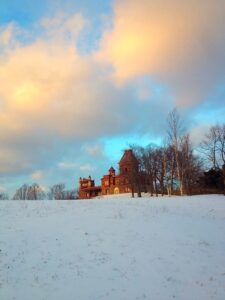Frederic Church’s Olana is a “treasure house”
Rena Zurofsky, Interim President

Winter Sunset photo by Julia Thomas, 2014
I have just completed my first two month working, happily, for The Olana Partnership. It has been a time of intense learning, including some surprises.
Before working here, I thought Olana (which loosely translates/is interpreted as a “treasure palace”) referred just to the House, sitting atop a lovely property. But in fact, Olana refers to the entire property, which is also a work of art. Specifically, it is a work of art by Frederic Church.
As Church aged, he experienced what many plein air and other painters have—arthritis. And so he cast about for another way to indulge his creative urge. He was already designing the house, but how to indulge his desire to paint? He chose the landscape. He considered each vista and chose for it trees, plants, lake or meadows, as if he was creating one of his magnificent painted vistas—based on true natural phenomena, but composed as perfectly as a dream. He carefully sculpted the roadways for light and shadow, close study or wide views past the Catskills and Berkshire Taconics into into the incandescent sky he’d previously painted to universal acclaim.
As Mark discussed in the last Insider’s Perspective, he turned this hillside—from which he’d sketched views as a young man, studying beside Thomas Cole—into a series of landscape paintings. Whether viewing from the bottom of the hill where our offices stand, or from the carriage roads, or from the heights surrounding the house, or the house itself, each angle is a landscape painted by Church. They are unmistakable: the sky changing colors over swathes of hills, mountains and trees; the dotted signs of “civilization” dwarfed by all that surrounds them. Olana is a supreme example of the “American Sublime” at the heart of the Hudson River School.
As I began working here, the Matisse Cut-Outs exhibition was taking New York City by storm. Matisse turned to cut-outs as a result of arthritis and ill-health, the way Church turned towards the land. With his scissors he could the play with color and form endlessly to create works that are a marvel of exuberance and joy. The visions of both of these aging artists were undimmed. I am struck by their similar energy and optimism despite the infirmities of aging, and the indignities of being outside of the current fads. And each of them now are prized as visionaries in their own way.
Artists make art at any age, in any age, with whatever is to hand, be it dust (Vic Muniz), straws and Dixie cups (Tara Donovan), paper napkins (Picasso, everybody), colored paper or the land itself. Frederic Church’s Olana is a “treasure house,” that teaches me that, despite indignities, aging has its attractions if we embrace it as a creative spark.

